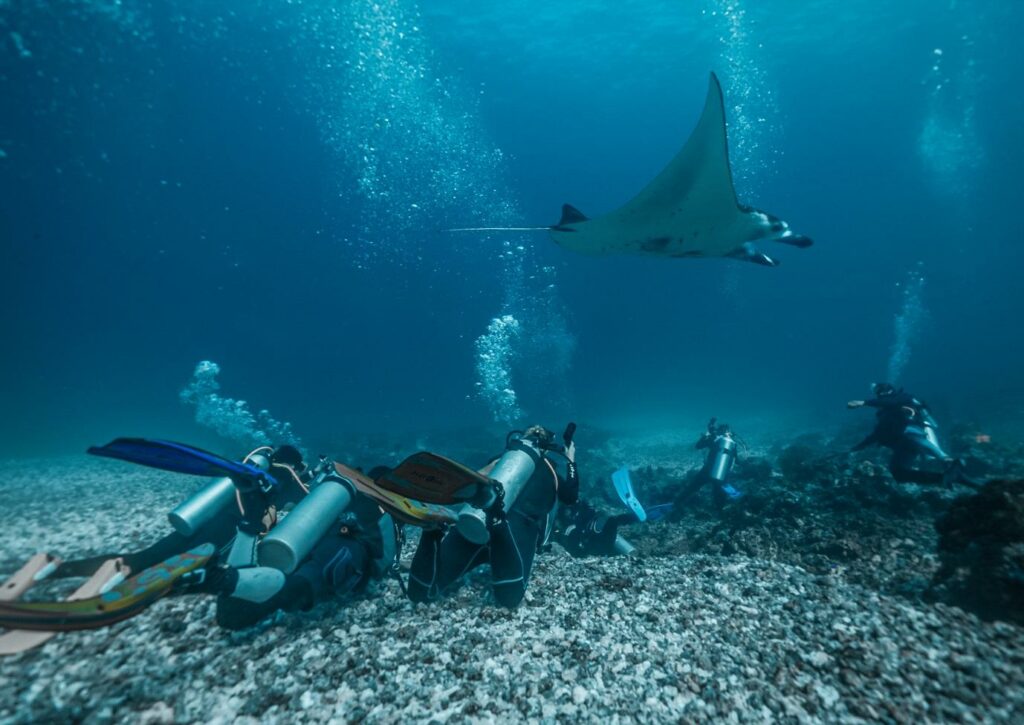I still remember the first time a manta ray passed over my head in Raja Ampat. A shadow with wings five metres long slid between me and the surface, moving so slowly and so smoothly that the whole ocean seemed to pause and watch.
I’ve spent countless dives here waiting in the current for that shape to appear again – sometimes one manta, sometimes a whole line of them, circling calmly above the cleaning stations.
As a diver who returns to Raja Ampat every season, I’m often asked what makes these animals so special, and what’s really going on when you see them looping above the reef or lining up in a “manta train”.
In this guide, I’ll share fun facts about manta rays, combined with what I’ve learned watching them in Raja Ampat. This covers how big they really get, how they feed and think, why they come back to the same spots again and again, and how divers can enjoy unforgettable encounters without disturbing them.
Manta ray facts (Raja Ampat)
- Wingspan: up to ~7 m for the largest oceanic mantas
- Weight: up to ~1,500 kg (for big oceanic individuals)
- Lifespan: 40–50+ years
- Diet: Plankton – tiny animals drifting in the water
- Species seen here: Reef manta (Mobula alfredi) and oceanic manta (Mobula birostris)
- Behaviour: Cleaning stations, feeding trains, seasonal migrations
Here are some fun facts that reveal how special they truly are, especially when you meet them in places like Raja Ampat.
Manta Ray Fun Facts

1. Their wingspan is wider than some small speedboats
Depending on the species, adult mantas can reach impressive sizes:
- Reef mantas (Mobula alfredi) This Manta species usually grow up to around 4–5 metres in wingspan
- Oceanic mantas (Mobula birostris) can exceed 6–7 metres
Seen from below, a large manta can briefly block out the light as it passes overhead. Despite this size, mantas are filter feeders, targeting tiny plankton rather than fish, and pose no threat to divers.
2. They have the largest brain of any knowns fish in the ocean
Manta rays (mobulid rays) have the highest brain-to-body mass ratios of any known fish studied so far, and the largest brains of all cartilaginous fish. Their brains include regions associated with learning, problem-solving, and social behaviour.
What this seems to mean in the water:
- Mantas frequently make deliberate, repeated passes over divers.
- They often adjust their approach, circling back as if to investigate.
- Local guides in Raja Ampat often observe the same Mantas at the same sites over many seasons. This suggests site fidelity and good spatial memory.
While scientists are careful not to over-interpret behaviour, current research strongly supports the idea that manta rays are among the most cognitively complex fish in the ocean.
3. They visit cleaning stations. A lot.
In areas like Manta Ridge, Manta Sandy, and Blue Magic in Raja Ampat, they repeatedly visit specific cleaning stations. It is a raised patches of reef where cleaner wrasse and other small fish remove parasites and dead skin.
Their behaviour in cleaning stations
- Mantas often line up or circle in a predictable pattern over the reef.
- Individuals may remain for many minutes while cleaners move across their belly, gills, and around the mouth.
- Local rangers monitor some of these cleaning stations and enforce regulations such as no anchoring, limited boat numbers, and controlled diver positioning to reduce stress on the animals.
For divers, understanding that a site is a cleaning station – not just a “manta spot” – helps explain why low-impact behaviour is important.
4. They can live around 40-45 years
Manta rays grow slowly, mature late, and reproduce rarely:
- Gestation is long (around a year).
- A female usually gives birth to just one pup, occasionally two.
- You’ll sometimes see claims that manta rays can live longer than 60 years. At the time of writing, there are no published studies confirming that exact age. Research from NOAA, IUCN and Manta Trust estimates that Manta Ray’s lifespan at 40–45+ years. This is based on demographic modelling and long-term photo-ID. [1][2][3]
Manta Rays’ populations increase slowly. Various threats such as targeted fishing, bycatch, and habitat damage can have long-lasting impacts. This is why protection measures in places like Raja Ampat Marine Park are so significant.
5. They fly underwater using the same physics as birds
Mantas don’t simply flap their fins to push water backwards. Their wing-like pectoral fins create lift, similar to a bird’s wing in air:
- The up-and-down motion of the wings generates forward thrust.
- The wide surface area provides excellent control in strong currents.
- This efficient design allows mantas to travel long distances while expending relatively little energy.
When you watch a manta from the side at a site like Manta Ridge, you are essentially watching a large, living hydrofoil move through the water.
6. Their spots are as unique as fingerprints
If you look at the underside of a manta, you’ll see a pattern of dark spots and markings, especially near the gills and belly. These markings are:
- Unique to each individual, comparable to a human fingerprint.
- Stable over time, which allows photo-identification.
Researchers and citizen scientists upload belly photos to ID databases. This has revealed:
- Regular movement of the same animals between different sites in Raja Ampat.
- Seasonal patterns, such as more frequent sightings during particular months when plankton is abundant.
If your dive operator participates in photo-ID projects, sharing your images directly contributes to manta research and conservation.
7. They sometimes queue politely for food
During strong currents or plankton blooms, mantas often switch into feeding mode. You might see:
- Mantas swimming in single-file “trains”, each following the slipstream of the one ahead.
- Large looping circuits, sometimes with several mantas rotating through the same plankton-rich patch.
- Open mouths and flared cephalic fins as they funnel water across their gill rakers to filter out plankton.
For divers, this is one of the best times to stay still, hold position, and observe from the side, rather than swimming into the middle of the feeding line.
8. They seem to enjoy human company more than we expect
Manta rays do not depend on humans, but in heavily dived areas they show consistent curiosity:
- Some individuals approach slowly and maintain eye contact.
- They may circle a diver or a small group multiple times if the divers remain still.
- Sudden fin kicks, chasing, or touching attempts typically cause them to leave the area.
Most reputable operators in Raja Ampat follow manta interaction guidelines, which usually include:
- Stay low and to the side of cleaning stations.
- Avoid swimming above mantas or blocking their path.
- Do not touch or attempt to ride them, even if they come very close.
Following these rules increases the chance that mantas will continue to use a site comfortably – which benefits both the animals and future visitors.
Frequently Asked Questions
What makes manta rays different from stingrays
Manta rays do not have a stinger, which makes them completely harmless to humans. They grow much larger than most stingray species and have wide, graceful wings that help them glide through the water. They are calm and curious, often approaching divers with gentle movements.
Where is the best place to see manta rays in Indonesia
Raja Ampat stands among the finest places on Earth to see manta rays. Sites such as Manta Ridge, Manta Sandy, and Blue Magic offer consistent encounters with both reef and oceanic mantas. The healthy ecosystem and protected zones create perfect conditions for them.
Are manta rays dangerous to humans?
No. Manta rays do not have stingers and display no aggression. They feed on plankton and are known for their gentle nature. Many mantas approach divers out of curiosity, sometimes circling slowly as they observe.
How long can manta rays live
While some sources suggest manta rays may live over 50 years, scientific studies based on long-term tracking and photo-ID currently estimate their lifespan to be around 40 to 45 years.
Why do manta rays visit cleaning stations
Cleaning stations are places where small fish remove parasites and dead skin. Mantas visit these locations regularly to stay healthy. Watching them hover calmly while cleaner fish work is one of the most peaceful sights in diving.
How can divers help protect manta rays
Divers can help by keeping a respectful distance, remaining calm, and avoiding rapid movements. Choosing responsible operators and supporting marine conservation efforts also protects manta populations.
References
- Primary demographic study
Smallegange, I. M., van der Ouderaa, I. B. C., & Tibiriçá, Y. (2016).
Effects of yearling, juvenile and adult survival on reef manta ray (Mobula alfredi) demography.
PeerJ, 4, e2370. https://doi.org/10.7717/peerj.2370
- NOAA giant manta ray profile
NOAA Fisheries. (2021, October 21). Giant manta ray (Mobula birostris).
U.S. National Oceanic and Atmospheric Administration.
https://www.fisheries.noaa.gov/species/giant-manta-ray
- Manta Trust oceanic manta profile
Manta Trust. (2025). Oceanic manta ray (Mobula birostris) species guide.
https://www.mantatrust.org/mobula-birostris

